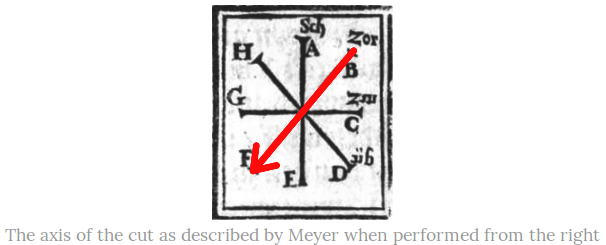Zornhauw
(→TL;DR) |
(→Considerations) |
||
| Line 26: | Line 26: | ||
On of the main benefits of the zornhau is that its cutting direction give it both a horizontal and vertical component to its momentum. This means that it can be used as a cutting parry to both vertical and horizontal strikes, relying on its greater horizontal component to parry vertical cuts (which have no horizontal momentum with which to oppose it), and likewise uses the vertical component to offset horizontal cuts (because they have no vertical momentum of their own). By the same reasoning it is more difficult to directly parry a zornhau with these single axis strikes. | On of the main benefits of the zornhau is that its cutting direction give it both a horizontal and vertical component to its momentum. This means that it can be used as a cutting parry to both vertical and horizontal strikes, relying on its greater horizontal component to parry vertical cuts (which have no horizontal momentum with which to oppose it), and likewise uses the vertical component to offset horizontal cuts (because they have no vertical momentum of their own). By the same reasoning it is more difficult to directly parry a zornhau with these single axis strikes. | ||
| + | |||
| + | ==Application== | ||
| + | |||
| + | The cut is often carried out best with a casting-out motion using a push-pull of the hands rather than bringing the arms in a purely chopping action. This gives superior reach and speed and allows the blade to rotate out to longpoint over the opponent's blade, using the momentum of the blade around a point of rotation about the hilt to give superior leverage over their blade. | ||
| + | |||
| + | While the cut can carry all the way through we very often want to end on-point, threatening the face in [[Langort]] and holding the opponent at a distance, forcing them to react to our point, thus taking the [[Vor]] from them. This is a classic way of taking the initiative. | ||
Revision as of 02:45, 29 June 2016
Contents |
Wrath Strike
A powerful diagonal strike from above.
Summary
- Diagonally downward cut, attacking the upper openings.
- Guard transitions: Zornhut – Wechsel
- Advantages: Powerful, the 45 degree angle gives it good structure both horizontally and vertically, so it is difficult to set aside and also effective in cutting into the opponent’s strike as a parry & strike at once.
- Disadvantages: This is the most common strike seen in most exchanges, as such opponents are usually ready for it.
Execution
The canonical zornhauw is carried out as follows:
- Begin in the guard zornhut with the left foot forward.
- Cast the blade out and downward so it comes around with a downward motion at around 45 degrees.
- As the blade’s tip passes the shoulder begin the passing step forward with the right foot, landing it at the blade passes through an angled, langort position.
- The blade continues its motion down and to the guard of wechsel on the left hand side.
Considerations
The zornhau is the most powerful of the strikes in Meyer’s system, and also one of the most versatile. It is simultaneously a block and strike, and can be carried all the way through and around for follow on strikes, or may be halted “on point” with the opponent to threaten with the point. We will begin with the cut all the way from the guard zornhut to wechsel.
The motion of the blade should maintain the same diagonal line throughout the strike, and the cutting line should be straight and not scallop downward to the vertical or across to the horizontal.
On of the main benefits of the zornhau is that its cutting direction give it both a horizontal and vertical component to its momentum. This means that it can be used as a cutting parry to both vertical and horizontal strikes, relying on its greater horizontal component to parry vertical cuts (which have no horizontal momentum with which to oppose it), and likewise uses the vertical component to offset horizontal cuts (because they have no vertical momentum of their own). By the same reasoning it is more difficult to directly parry a zornhau with these single axis strikes.
Application
The cut is often carried out best with a casting-out motion using a push-pull of the hands rather than bringing the arms in a purely chopping action. This gives superior reach and speed and allows the blade to rotate out to longpoint over the opponent's blade, using the momentum of the blade around a point of rotation about the hilt to give superior leverage over their blade.
While the cut can carry all the way through we very often want to end on-point, threatening the face in Langort and holding the opponent at a distance, forcing them to react to our point, thus taking the Vor from them. This is a classic way of taking the initiative.
